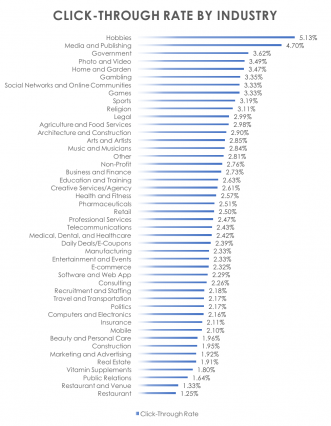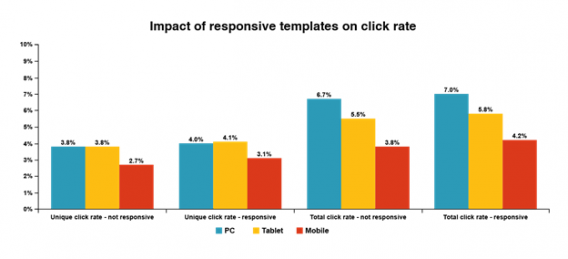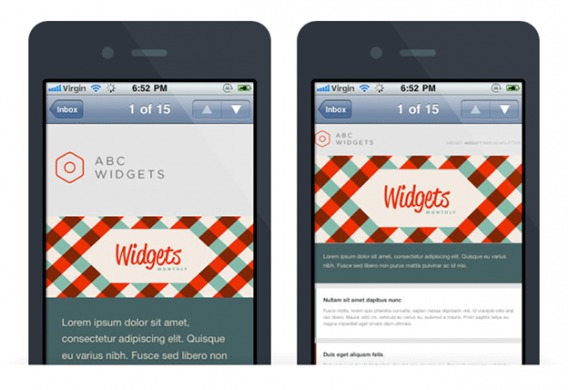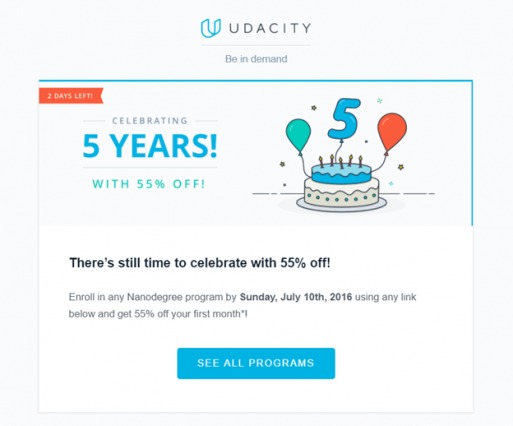When you ask email marketers for the metrics they track, click-through rate (CTR) is likely to be one of their first answers.
In email marketing, click-through rate lets you evaluate the success of your campaign and whether your copy, design, subject line, etc. are effective in capturing users.
With 57% of email marketers increasing their email marketing budget last year and email marketing continuing to deliver the highest on average return on investment, it is important to understand how understanding CTR can help improve the performance of email marketing campaigns.
It becomes even more important when you consider the 80% of 196 million emails that are left unopened every single day.
To help position CTR in email campaign evaluation, this article will define email CTR, compare the usefulness of CTR to other email marketing metrics, present email CTR benchmarks, and discuss actions to take to remedy low click CTRs.
Table of contents
What is email click-through rate?
Click-through rate for email is the percentage of people who clicked on at least one link in your email message. To calculate it simply divide the number of total people who clicked by the number of delivered emails and multiple that ratio by 100 to arrive at your email CTR percentage.
Of course, make sure you are not overcounting clicks. While most formulas will tell you that click-through rate is the number of clicks your emails get, what they mean is the number of individuals who clicked any link in your email. Therefore, if Bob clicks two links in your email, he counts as 1 click not 2.
To be more specific, there are two types of click-through rates: TCTR and UCTR.
TCTR
TCTR is total click-through rate and measures the total number of clicks an email’s links receive. Essentially, it measures how popular your message it (how much clicks it generates). There are a couple of things that add noise, however, to this measurement:
- People opening email and links on multiple devices
- People clicking on links repeatedly
- Firewalls opening links to check for malware
- Clickers clicking on links posted to social media
UCTR
UCTR is unique click-through rate and measures the number of unique clicks an email’s link receives.
By specifying unique link clicks, UCTR avoids some of the noise TCTR fails to account for.
To clarify, if you open an email on your laptop, click a link, and then click the same link from your phone, the number of clicks TCTR registers is 2, while the number of clicks UCTR registers is only 1.
Similarly, if you open the email and click on a link in the morning and later return to click on the link again at night, you would only contribute 1 click to UCTR but contribute 2 clicks to TCTR.
Both measurements are important for different scenarios.
TCTR can give you a clearer picture of how much traffic your email is generating in terms of shares, repeat engagement, and retainment (ie. UCTR won’t reward you for someone opening the same link 5 times to show the content to their friends).
UCTR, on the other hand, can give you a clearer number of how many links are visited by each unique individual.
This number may prove more useful to you if you are interested in how effective emails are in converting your readers. Because UCTR avoids the noise TCTR accounts for, most metrics on click-through rates ESPs provide measure UCTR rather than TCTR.
The definition we will stick to for the rest of this article is UCTR.
How does click-through rate compare to other email KPIs?
It’s important to consider and use click-through rate in tandem with other email key performance indicators to better understand the overall effect of your campaign.
We will focus on open rate in this article, but you may also want to check out conversion rate, bounce rate, and unsubscribe rate.
Open rate is the percentage of email recipients who open the email sent to them.
While many marketers are focused on optimizing for this metric through changing subject links to attract more clicks, over emphasis on open rate can be detrimental.
This is because having a great open rate on its own doesn’t tell you anything about the effectiveness of your campaign. You may have many recipients open your email, but if none of them convert or open your external links, your email campaign did not accomplish any of your goals.
Rather, be sure to use open rate alongside another metric like click-through rate. This allows you to pinpoint the pain areas of your email campaigns.
In fact, email marketers have combined these metrics into a final computation – click to open rate (CTOR).
Unlike click-through rate, which takes clicks as a percentage of all subscribers, click to open rate looks at clicks as a percentage of opens. This metric avoids misrepresentations of email effectiveness by only evaluating responses of recipients who read your email. Therefore, CTOR does not punish you for unopened emails and isolates the effect of the actual email message from the impact of list composition, situational context, and subject line content.
Let’s walk through an example to see how the differences between CTR and CTOR affect the perceived effectiveness of your email campaign.
CTR vs CTOR
Consider a firm that has a weekly newsletter. They have 1000 subscribers and on average, 500 of these subscribers open the newsletter. Of those 500 subscribers who open the newsletter, about 350 click on an external link within the newsletter.
- OPEN RATE: 500 / 1000 * 100 = 50%
- CTR: 350 / 1000 * 100 = 35%
- CTOR: 350 / 500 * 100 = 70%
Now, seeing that the email campaign is fairly (extremely) successful, the firm decides to purchase an email list that brings up the total number of subscribers to 5000. The firm launches the new campaign and finds that none of the 4000 email list subscribers open the email. Their number of opens and clicks remain at 500 and 350 respectively.
- OPEN RATE: 500 / 5000 * 100 = 10%
- CTR: 350 / 5000 * 100 = 7%
- CTOR: 350 / 500 * 100 = 70%
Notice how the email campaign open rate and CTR dropped substantially, yet the CTOR remains high at 70%. This is because the effectiveness of the email itself did not change, it is simply targeted at the wrong audience – loyal readers – instead of the people on the email list the firm just purchased.
Therefore, email segmentation and personalization would be a more proper fix in this situation than changing the content of the already effective email.
What is a good email click-through rate?
While industry benchmarks serve as a good comparison point to see where you fall amongst your competition, it is more important to focus on improvement. If you are constantly improving your performance, you shouldn’t be too worried about meeting “benchmarks.”
However, you can (and should) always be aware of average CTRs to properly evaluate the performance of your campaigns.
Here’s some data from MailChimp on the average click-through rates by industry:
Alternatively, here’s the data for average click to open rates by industry:
How to improve your email click-through rate
Many factors affect your email click-through rate. There are the obvious: subject lines, calls to action, design, copy, etc.
But there are also factors most typically don’t consider.
For example, link position, time email is sent, link emphasis, etc. may all affect whether someone clicks on your email link.
Despite the certain degree of randomness involved in running successful email campaigns, there are a few steps you can take to improve the effectiveness of your emails.
Tip #1: Optimize for Mobile
Today, most people will view your email first or even only on mobile.
With phones more conveniently around (and constantly around), it is no surprise mobile optimization is one of the most important factors affecting email campaign successfulness.
According to Litmus, while desktop represents only about 16% of all opened mail, mobile represents an impressive 54%.
This means you’ll need to make sure your email is attractive and accessible for users of all devices – especially mobile. If your email is even slightly difficult to read on the phone, you may be losing out on clicks.
We suggest using mobile responsive templates. This means you want to send emails that automatically adjust in terms of text, images, and buttons to fit different screen sizes. Responsive design is preferable to mobile-friendly templates that simply scale content down rather than reformat email layout.
Research shows emails using responsive templates get higher click-through rates regardless of device. They are particularly effective in lifting the click-through rates of mobile email campaigns (2.7% to 3.1%).
Luckily, most email service providers provide mobile responsive email templates that are easy to use. But, if you are up for the challenge, check out this great guide from Campaign Monitor to learn more about designing your own responsive email messages.
(Notice how the unoptimized email on the right is much less effective and harder to read than the optimized email on the left.)
Take it a step further and make sure your external links link to a website that is mobile friendly. This helps make sure you are providing a positive experience for the email recipient from beginning to end.
Lastly and most importantly, even if you don’t optimize for mobile with a responsive template, make sure to preview your email on all devices before you send them. What appears right on your desktop screen may be funky on your tablet or your phone.
Email service providers like Mailigen give you the option to view your email on multiple devices – never send an email without reviewing first!
Tip #2: Stick to One, Effective Call to Action (CTA)
Sometimes, choice can be demotivating.
This is because of our psychological inability to make decisions when we have too many choices (called action paralysis).
This condition exists in all forms of marketing and sales. Recall a time when you went shopping, have you ever entered the fitting room with too many pieces of clothing and left unable to settle on anything? The same phenomenon occurs in email marketing.
Consider HelpScout, which increased the CTR of their newsletters by 17% after trimming down the amount of content offered. Originally, they offered a blog broadcast that sent out new posts in clumps of 5-6. Intuition said more content meant more engagement. Unfortunately, the results didn’t follow through.
Instead, when HelpScout changed the format of its newsletters to include only one call to action (their newest blog post), CTR jumped dramatically. Other companies, like Whirlpool, have also been able to increase CTR by limiting their CTAs.
On the topic of CTAs, you might want to consider using HTML for your buttons. This is because most email clients won’t display images (for security, safety, and privacy reasons). To get around these measures, you’ll want to design your own buttons through code snippets instead of using and simply linking up a button image. Campaign Monitor offers a great tool for creating bulletproof email buttons if you don’t have a UX background.
HTML buttons also offer two other upsides. Namely, they are responsive (mobile optimization) and they will decrease your email load times by reducing the amount of included images.
Tip #3: Choose the Right Images
According to Vero’s analysis of over 5000 email campaigns, campaigns with images had a 42% higher click-through rate than campaigns without images.
This is because images are a powerful way to engage, intrigue, and entice.
You shouldn’t expect to improve the quality of your campaign by simply throwing a bunch of pictures into your email. You need to choose images that fit your message and appeal to your readers.
Here’s an example of an email campaign that gets images right:
Notice how the image accomplishes the goal of summarizing the email message, creating a sense of urgency, and pushing forth a sales pitch, without being intrusive or overly busy.
Of course, when using images in your email campaign, make sure to include alt text just in case your images don’t display. In fact, you might want to send preview emails where the images are blocked by default to evaluate the effectiveness of your campaign without emails.
This way you can avoid sending situations like this:
If you are looking for more resources on how to improve the effectiveness of your email campaigns, here are a few articles to check out:
- The Advanced Guide to Promotional Emails That Convert
- 8 Ways To Keep Your Email Engagement Alive & Lucrative
- 7 Underused Email Campaigns That Will Help You Nail Your Conversions
- How to Generate More Sales From Your Email Marketing Campaigns
- How Your Customers Actually Read Your Emails
Conclusion
In the end, email marketing is not usually regarded as being overtly glamorous, but it is an important one and a lot of it comes down to trial and error. Run A/B tests, analyze your data, and pay attention to your metrics. Where does your click-through rate stand?
Next lesson or Download guide as PDF
-
What is Click-Through Rate? Click-Through Rate Definition
What is a click-through-rate, actually? In one way, it’s a straightforward question, but on the other hand, it’s a metric that is used and abused by many different channels and in many different ways. -
What is a “Good” Click-Through Rate? Click-Through Rate Benchmarks
"What's a good click through rate?"...common question, no clearcut answer. This guide will cover industry and platform benchmarks so you can see where you stand. -
Email Click-Through Rate: What You Need to Know to Succeed
When you ask email marketers for the metrics they track, click-through rate (CTR) is likely to be one of their first answers. This article covers everything to do with email CTR. -
PPC Click-Through-Rate: What it Means and How to Use It (and Improve It)
Click-through rate (CTR) is one of the most important metrics you should be monitoring when implementing paid customer acquisition. -
The SEO Impact of Click-Through Rate (What You Need to Know)
How does click-through-rate affect SEO rankings? It’s a common question and debate in the optimization space. -
Click-Through-Rate vs Conversion Rate: What’s the Difference?
This article covers a CRO question: what's the difference between CTR and conversion rate and why does it matter? -
Conclusion
Summary and wrap up.













